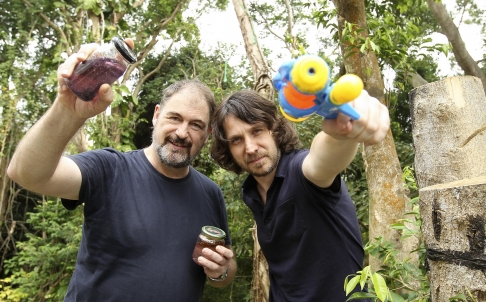Shaun Martin was still lying in bed after waking up one spring morning two years ago, when he was startled by police and firefighters standing on the balcony of his first floor flat on Lamma Island. Dressing quickly, he went out to investigate. That's when he found "a bloody great big tree above me", recalls Martin, an education consultant. The tree had crashed into a window on the floor above.
His upstairs neighbour, businessman Chris Lonsdale, was furious. "Some a****le had cut the tree and I had no idea who it was," he says.
According to the police it was poachers. It turns out the tree was an Aquilaria sinensis, a species sometimes known as the incense tree, and poachers in a hurry to harvest the valuable heartwood had simply cut through much of the trunk, causing it to fall.
When infected by a certain type of mould, incense trees make an aromatic resin that permeates its core, yielding what is often called agarwood. Native to southern China the fragrant wood has long been used to make incense, joss sticks, prayer beads, oil and carvings. The extracted resin, chen xiang, is also used as a traditional Chinese medicine.
Indiscriminate harvesting has almost wiped out incense trees from the mainland, prompting poachers to turn to Hong Kong where stands can still be found in the wild, because local woodlands are relatively protected under the Forests and Countryside Ordinance.
Similarly threatened worldwide, Aquilaria sinensis is categorised as a vulnerable species on the red list of the International Union for the Conservation of Nature and is listed under Appendix Two of the Convention on International Trade in Endangered Species of Wild Fauna and Flora (Cites), which means its trade should be restricted.
"Most of the bigger trees have already been stolen," says Jim Chi-yung, a tree expert and professor of geography at the University of Hong Kong. "The poaching is very serious. With the larger trees gone, the poachers are beginning to move to the lesser trees."
Although incense trees are relatively common here, he questions the government's failure to place incense trees on the threatened species list. "In terms of numbers it may not be endangered, but [because of poaching] the population will surely continue to decline."
The Agriculture, Fisheries and Conservation Department has, however, responded to felling by poachers by planting more than 49,000 saplings between 2009 and 2013.
As the resin becomes increasingly valuable - one gram of agarwood is now estimated to be worth up to HK$12,580 on the mainland market - the plunder of incense trees worsens in Hong Kong. Police records show there were 76 reported cases of tree poaching (both Buddhist pines and incense trees) in 2011 and 71 cases so far this year.
Most reported cases have occurred in the lowland woods of Sai Kung or southern Lantau, some on an appallingly large scale. Earlier this year, Mui Wo residents discovered a stand of 1,000 incense trees behind Man Mo temple had been felled overnight with poachers making away with almost the entire haul.
Previously poachers would only harvest the most resinous trees. Now, in their haste to make money, they are increasingly making off with trees whether they are resinous or not. After a series of incidents in Sai Kung, a police crackdown has seen reports of poaching fall off. It seems the poachers have moved on to the easier pickings of Lamma Island. Sai Kung resident Karina O'Carroll credits the police for responding effectively to alerts.
Still, a concerned resident who was a former member of the Sai Kung police department worries that the poachers are more sophisticated than people give them credit for. "The ones I've seen appear to be very professional ... they almost appear to be ex-PLA or something like that ... I've heard a story, which has not been confirmed, that they've even set up a training camp on the other side of the border for tree cutters," he says.
Lee Bray, a 20-year resident of Sai Kung who routinely walks his dogs in areas popular with poachers, says he has had a series of brushes with poachers he suspects are mainlanders. Last year, he surprised a poacher, who jumped from a bush, knocked him down and ran off. Another time he cornered one up a tree.
As poachers turned their attention to Lamma Island in recent years, the handful of police officers there (only four or five are on duty at one time) are being stretched to their limit.
Incense trees often grow on people's properties or right next to them, and because poachers often remove chunks of wood from the base, severely weakening the trunk, the safety of residents is becoming an issue.
But on an island covering 13.5 square kilometres, the police simply can't respond quickly enough to prevent poaching or catch the criminals. According to residents, police suspect most of the stolen wood is smuggled to Maoming, a city in southwest Guangdong which has become a major market for agarwood products.
Police say they are aware of the target areas and have stepped up patrols. They are also working with the AFCD to keep an eye on potential sites.
Success, however, has been limited. In 2010, Lamma police arrested two men in possession of 5kg of incense tree bark and wood, and in 2011 they caught a man in possession of 1.2kg of bark as well as cutting tools.
Recent changes in the law mean poachers can now be tried under the Theft Ordinance, which imposes jail sentences of between four weeks and 51 months.
Roy Ng Hei-man, assistant campaign manager for the Conservancy Association, reckons the Agriculture, Fisheries and Conservation Department could still do much more.
"It's a critical issue not only on Lamma Island but in other rural areas in Hong Kong. Even within our country parks we receive reports of unauthorised incense tree felling," he says.
Places like Lamma Island may be difficult to police but it's quite ridiculous that poaching goes on within country parks where the AFCD has jurisdiction, he adds. "The AFCD should start with the trees in protected areas."
Some Lamma residents, however, have had enough.
Just three weeks ago Martin woke in the middle of the night to the sounds of sawing. He looked out to find a poacher "perched on a tree ... cutting a major branch off". He alerted the police, but by the time officers arrived the poacher had run off.
Frustrated by the little headway police are making, some residents have taken the law into their own hands.
Lonsdale has had some success spiking trees - strategically driving nails into the trees so that poachers can't cut them down - although his calls to booby trap the trees with paint bombs and to arm neighbours with paintball guns so that the police will be able to better identify the poachers have not taken off.
Other schemes, however, are starting to gain traction.
Some neighbours have installed motion-detecting flood lights and put up neighbourhood watch signs to deter poachers.
Many have joined a WhatsApp group to help inform each other about suspicious activity. There is even talk of draping rubber snakes on the trees, playing on the widely held notion that Lamma Island is awash with poisonous snakes.
Meanwhile, Martin and his girlfriend Natalie Belbin have come up with a characteristically Lamma approach to the problem - they are making an arsenal of glitter bombs (glass jars full of glitter and water) and filling squirt guns with glitter water.
"If [the poachers] come back, we will go to the balcony, unscrew [a glitter bomb], get some water guns and bam bam bam there you go," says Martin . "It's not going to hurt if you throw it at someone ... and when the police turn up we'll tell them 'Okay, you're looking for a fabulous looking guy with glitter all over his hair, face and clothes."



